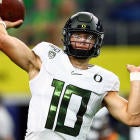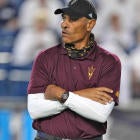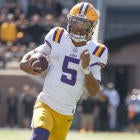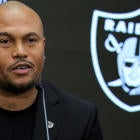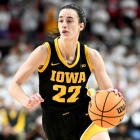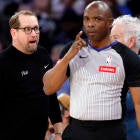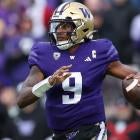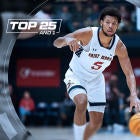Justin Herbert completed 75.6% of his throws in Oregon's narrow defeat at the hands of Auburn on Saturday, and while that figure was inflated by an array of short passes, the Ducks' experienced quarterback made a small collection of fine throws throughout the game.
But the blips were there too.
Let's go inside Herbert's effort -- something we'll do every week here at CBS Sports -- and provide some of the finer details of his somewhat up and down performance.
What he did well
This was the most polarizing play of the game from Herbert because it started badly but ended outstandingly.
Herbert received the shotgun snap and instantly pump faked. A second later, he felt pressure up the middle. Instead of staying square to the target, he morphed into a running back and started to run out of the pocket, which happened to be toward star edge defender Nick Coe on the outside. Not good.
But, instead of continuing his premature scramble, Herbert located a receiver deep on the other side of the field, reset his feet and shoulders, prepared for a big hit, and launched the football into the end zone. His wideout had a size advantage. Herbert gave him a chance to make a play. And he did. Touchdown.
The dropping of the eyes and attempting to run out of the pocket at the first sign of pressure is concerning. However, it was as if Herbert instantly realized he made a pocket-presence mistake and immediately atoned by morphing back into a quarterback and making a spectacular throw.
In my preseason preview of Herbert's game, I mentioned his stellar throwing-on-the-run capability, and there were flashes of it against the Tigers.
From the end zone view, check this thrown down the field to a spot where only his receiver could catch it. Note how the ball was zipped to its target but had enough touch to fly over an underneath linebacker.
Herbert's footwork, timing, and obviously his accuracy needed to be exact on this play, and they were. While the coverage wasn't air tight, he still delivered the football slightly low and outside to keep it out of harm's way.
Speaking of connecting on tight window throws, Herbert did just that on a big third and long in the red zone in the third quarter. While his pocket was kept almost perfectly clean, he naturally stepped up into the pocket to move away from the edge defenders. A byproduct of doing that provided his pass with a tick more velocity en route to its target.
That Auburn defender was in full extension to break up the pass, but Herbert calmly fit the football in. While not the most difficult throw he'll complete this year, it was a fine demonstration of how accurate he can be in critical situations.
Where he must improve
Herbert's pedestrian yards-per-attempt figure (6.7) was more about Oregon's scheme than his individual performance, but despite completing nearly 76% of his throws, not every pass was pretty.
On a 1st and 10 near midfield -- an ideal time to take a shot deep -- Herbert was given a gorgeous pocket by his offensive line and stared at a slot fade down the field with no one around him.
While the receiver didn't get a step on his defender, there was plenty of room toward the sideline for a completion to be made. What happened? A blatant overthrow by Herbert that didn't even give his wideout a chance to sky for the football.
Herbert threw the ball 40 yards on a rope, yet it was a missed opportunity that popped up a fair amount of the time last season. Those misses happen to the best quarterbacks in some instances but need to occur less frequently from Herbert this year if he is to be considered a No. 1 overall pick candidate. Accuracy on throws made beyond 20 yards accentuates his strong arm.
On a rather critical 2nd and 7 in the fourth quarter with a one-score lead inside his own 25-yard line, Herbert had another misfire on a throw that simply has to be completed.
The play looked to be designed for the slot receiver near the top of the screen to get close to the first down on an out route. That wideout got plenty of cushion pre-snap, and while the cornerback did close on the football as it arrived, an accurate throw -- instead of low and outside -- would've likely been completed to set up, at the very least, third and short.
Instead, Herbert's receiver couldn't corral the errant throw. Oregon wasn't able to convert a first down on the next play and punted. That play was a classic example of the importance of ball placement, even on short throws.
Takeaway
To me, Oregon went into this game with a strange game plan especially considering the presence of Herbert and the team's incredibly experienced, majorly hyped offensive line. Early on, the Ducks offense was based on running and their quarterback getting the ball out of his hands in a hurry on a variety of quick screens and swing passes.
While those throws obviously mitigated Auburn's pass rush, the speed of the defense's second and third level defenders stopped big plays from occurring after the catch. It was like the Ducks' offensive coordinator didn't want to put too much on Herbert's plate. And outside of an early wide open completion on a deep crosser, the improvised touchdown, and the overthrow deep, the Ducks did not test the Tiger defense down the field.
Could injuries at receiver -- most namely marquee transfer Juwan Johnson -- been a reason for that? Maybe. But it was as if Oregon did not want to take the reins off Herbert and it was overly concerned about Auburn's pass rush. Herbert didn't play amazingly, but when he was asked to do a few next-level things, he typically executed well. He was just kept under wraps for a good portion of the contest. Weird.
The consistency of Herbert's accuracy needs to improve, yet those high-caliber flashes were undoubtedly there against one of the best defenses in the country.












